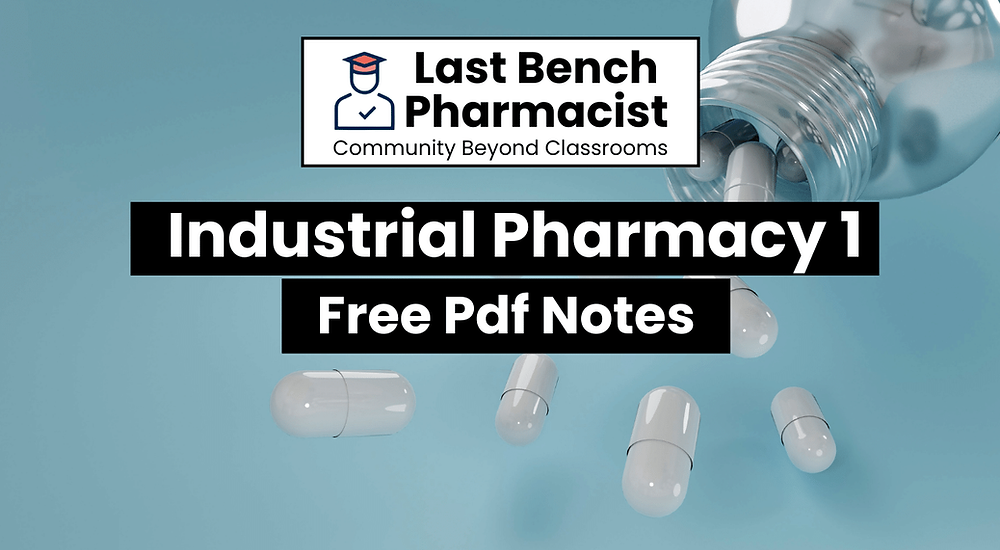



#bpharmnotes #bpharmindustrialpharmacynotes #bpharmpdfnotes
Yo, Last Bench Pharmacist! Ready to ditch the daydreams of owning a private island with that sweet pharmacist salary and get down and dirty with the real workhorses of the drug world? I’m talking tablets that’ll crush your hopes faster than a failed compression test, capsules that’ll dissolve your dreams quicker than a timed release placebo, and suspensions that’ll stir up your anxiety like a forgotten vial of shaken Benadryl. So grab your trusty spatula (cause who needs a fancy pill counter, right?), dust off your grandma’s mortar and pestle (vintage is in!), and prepare to get hands-on with the gritty, glorious world of B Pharm Industrial Pharmacy 1 Pdf Notes with your favorite Last Bench Pharmacist as your guide.
Just remember, if the equations get too mind-numbing, there’s always the escape hatch: blame the humidity and head to the nearest ice cream shop. But hey, at least you’ll have some hilarious stories to tell while mixing powders and cursing lactose fillers, right?
Scope:
Course enables the student to understand and appreciate the influence of pharmaceutical additives and various pharmaceutical dosage forms on the performance of the drug product
Objectives: Upon completion of the subject student shall be able to:
Know the various pharmaceutical dosage forms and their manufacturing techniques.
Know various considerations in development of pharmaceutical dosage forms
Formulate solid, liquid and semisolid dosage forms and evaluate them for their quality
Preformulation Studies: Introduction to preformulation, goals and objectives, study of physicochemical characteristics of drug substances.
a. Physical properties: Physical form (crystal & amorphous), particle size, shape, flow properties, solubility profile (pKa, pH, partition coefficient), polymorphism
b. Chemical Properties: Hydrolysis, oxidation, reduction, racemisation, polymerization BCS classification of drugs & its significant Application of preformulation considerations in the development of solid, liquid oral and parenteral dosage forms and its impact on stability of dosage forms.
a. Introduction, ideal characteristics of tablets, classification of tablets. Excipients, Formulation of tablets, granulation methods, compression and processing problems. Equipments and tablet tooling.
b. Tablet coating: Types of coating, coating materials, formulation of coating composition, methods of coating, equipment employed and defects in coating.
c. Quality control tests: In process and finished product tests
Liquid orals: Formulation and manufacturing consideration of syrups and elixirs suspensions and emulsions; Filling and packaging; evaluation of liquid orals official in pharmacopoeia
a. Hard gelatin capsules: Introduction, Production of hard gelatin capsule shells. size of capsules, Filling, finishing and special techniques of formulation of hard gelatin capsules, manufacturing defects. In process and final product quality control tests for capsules.
b. Soft gelatin capsules: Nature of shell and capsule content, size of capsules,importance of base adsorption and minim/gram factors, production, in process and final product quality control tests. Packing, storage and stability testing of soft gelatin capsules and their applications
Pellets: Introduction, formulation requirements, pelletization process, equipments for manufacture of pellets
a. Definition, types, advantages and limitations. Preformulation factors and essential requirements, vehicles, additives, importance of isotonicity
b. Production procedure, production facilities and controls, aseptic processing
c. Formulation of injections, sterile powders, large volume parenterals and lyophilized products. d. Containers and closures selection, filling and sealing of ampoules, vials and infusion fluids. Quality control tests of parenteral products.
Ophthalmic Preparations: Introduction, formulation considerations; formulation of eye drops, eye ointments and eye lotions; methods of preparation; labeling, containers; evaluation of ophthalmic preparations
Formulation and preparation of the following cosmetic preparations: lipsticks, shampoos, cold cream and vanishing cream, tooth pastes, hair dyes and sunscreens.
Definition, propellants, containers, valves, types of aerosol systems; formulation and manufacture of aerosols; Evaluation of aerosols; Quality control and stability studies.
Materials used for packaging of pharmaceutical products, factors influencing choice of containers, legal and official requirements for containers, stability aspects of packaging materials, quality control tests.
Just remember, if the equations get too mind-numbing, there’s always the escape hatch: blame the humidity and head to the nearest ice cream shop. But hey, at least you’ll have some hilarious stories to tell while mixing powders and cursing lactose fillers, right?